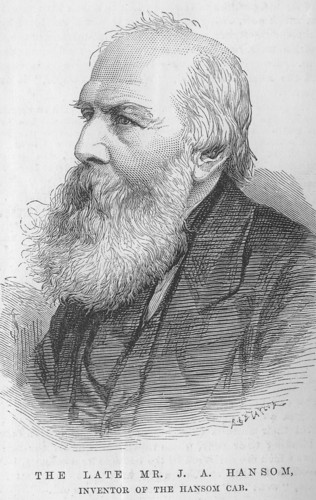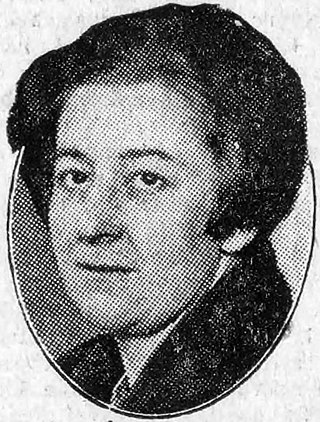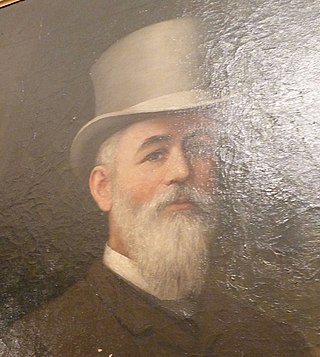
Sir George Gilbert Scott, largely known as Sir Gilbert Scott, was a prolific English Gothic Revival architect, chiefly associated with the design, building and renovation of churches and cathedrals, although he started his career as a leading designer of workhouses. Over 800 buildings were designed or altered by him.

The Royal Shakespeare Theatre (RST) is a grade II* listed 1,040+ seat thrust stage theatre owned by the Royal Shakespeare Company dedicated to the English playwright and poet William Shakespeare. It is located in the town of Stratford-upon-Avon – Shakespeare's birthplace – in the English Midlands, beside the River Avon. The building incorporates the smaller Swan Theatre. The Royal Shakespeare and Swan Theatres re-opened in November 2010 after undergoing a major renovation known as the Transformation Project.

Edward Middleton Barry RA was an English architect of the 19th century.

William Charles Macready was an English stage actor. The son of Irish actor-manager William Macready the Elder he emerged as a leading West End performer during the Regency era.

Joseph Aloysius Hansom was a British architect working principally in the Gothic Revival style. He invented the Hansom cab and founded the eminent architectural journal The Builder in 1843.
The year 1932 in architecture involved some significant events.

Elisabeth Whitworth Scott was a British architect who designed the Shakespeare Memorial Theatre at Stratford-upon-Avon, England. This was the first important public building in Britain to be designed by a female architect.

Leeds Minster, or the Minster and Parish Church of Saint Peter-at-Leeds is the minster church of Leeds, West Yorkshire, England. It stands on the site of the oldest church in the city and is of architectural and liturgical significance. A church is recorded on the site as early as the 7th century, although the present structure is a Gothic Revival one, designed by Robert Dennis Chantrell and completed in 1841. It is dedicated to Saint Peter and was the Parish Church of Leeds before receiving the honorific title of "Minster" in 2012. It has been designated a Grade I listed building by Historic England.

George Corson (1829–1910) was a Scottish architect active in Leeds, West Yorkshire, England.

Hippolyte Jean Blanc was a Scottish architect. Best known for his church buildings in the Gothic revival style, Blanc was also a keen antiquarian who oversaw meticulously researched restoration projects.

Henry Inigo Triggs (1876–1923) was an English country house architect and designer of formal gardens, and author.

Robert Mawer was an architectural sculptor, based in Leeds, West Yorkshire, England. He specialised in the Gothic Revival and Neoclassical styles. He created the Neoclassical keystone heads on St George's Hall, Bradford and on Moorland's House, Leeds, and was working on the keystone heads at Leeds Town Hall when he died. He was a founding member of the Mawer Group of Leeds architectural sculptors, which included his wife, Catherine Mawer, his son Charles Mawer, and his apprentices William Ingle, Matthew Taylor and Benjamin Payler, who all became sculptors with their own careers. Many of the buildings enhanced with sculpture by Robert Mawer are now listed by Historic England.

Charles Mawer (1839–1903) was an architectural sculptor, based in Leeds, West Yorkshire, England. He was the son of sculptors Robert and Catherine Mawer and the cousin of William Ingle. He was apprenticed to his father, and worked within the partnership Mawer and Ingle alongside his cousin William and his own mother between 1860 and 1871, and then ran the stone yard himself until he formed a partnership with his fellow-apprentice Benjamin Payler in 1881. Following that date, his whereabouts and death are unknown. His last major work for Mawer and Ingle was Trent Bridge, where he carved alone, following the death of William Ingle. He is noted for his work on the rebuilding of the mediaeval Church of St Michael and All Angels, Barton-le-Street, completed in 1871, where he repaired and recreated damaged and missing Romanesque carvings, and for his carving on William Swinden Barber's 1875 Church of St Matthew, Lightcliffe. Charles' last known work ornaments another Barber church: the 1880 Church of St Thomas the Apostle, Killinghall. Charles was a member of the Mawer Group of Leeds architectural sculptors, which included those mentioned above, plus Matthew Taylor.

Benjamin Payler, , was a sculptor, stone and marble mason. He was apprenticed to Catherine Mawer, alongside fellow apprentices Matthew Taylor and Catherine's son Charles Mawer. He formed a business partnership at 50 Great George Street with Charles Mawer in 1881. There is no known record of Charles after that. Payler continued to run the business there under his own name. In his day, he was noted for his 1871 bust of Henry Richardson, the first Mayor of Barnsley, his keystone heads on the 1874 Queen's Hotel in the same town, and his architectural sculpture on George Corson's 1881 School Board offices, Leeds. Payler was a member of the Mawer Group, which included the above-mentioned sculptors, plus William Ingle.

Isaac Thomas Shutt was an architect, a farmer, and the proprietor of the Old Swan Hotel, Harrogate, then in the West Riding of Yorkshire, England, from 1849 to 1879. In 1842, at the age of 24 years, he designed the Royal Pump Room, Harrogate, now a Grade II* listed building. In partnership with Alfred Hill Thompson he co-designed the Church of All Saints, Harlow Hill.

John Wormald Appleyard was a British sculptor and monumental mason based in Leeds, West Yorkshire, England.

18 Park Row, Leeds, once known as Abtech House and more recently as Kenneth Hodgson House, is a Grade II listed building in Leeds, West Yorkshire, England. The building on the east side of Park Row, Leeds was built as offices for the West Riding Union Bank.
William Frederick Unsworth (1851–1912) was an English architect.

Frederick Stead Brodrick was an architect based in Kingston upon Hull, England.


















